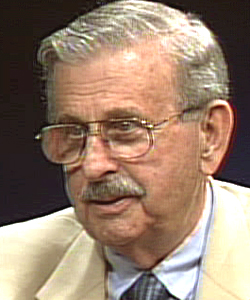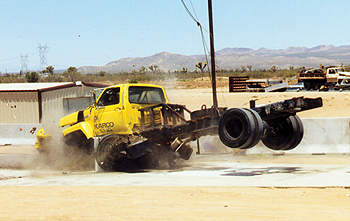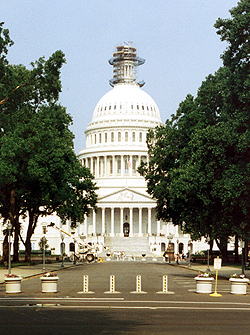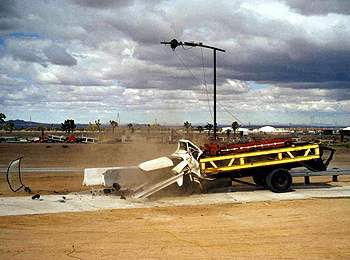|
|
|
SCV NEWSMAKER OF THE WEEK:
Harry Dickinson
President, Delta Scientific Corp.
Interview by Leon Worden
Signal City Editor
Sunday, August 1, 2004
(Television interview conducted July 21, 2004)
 "Newsmaker of the Week" is presented by the SCV Press Club and Comcast, and hosted by Signal City Editor Leon Worden. The program premieres every Wednesday at 9:30 p.m. on SCVTV Channel 20, repeating Sundays at 8:30 a.m.
"Newsmaker of the Week" is presented by the SCV Press Club and Comcast, and hosted by Signal City Editor Leon Worden. The program premieres every Wednesday at 9:30 p.m. on SCVTV Channel 20, repeating Sundays at 8:30 a.m.
This week's newsmaker is Harry Dickinson, founder and president of Delta Scientific Corp., a manufacturer in Valencia. The following interview was conducted July 21. Questions are paraphrased and some answers may be abbreviated for length.
Signal: Your company is really on the front lines in the war on terrorism. Tell us what you make.
Dickinson: We build a series of devices that will stop an aggravated attack by a suicide bomber, for example. An immovable wall that says, "no go, no further," and does it effectively. Gates that will withstand an 18-wheeler running at 50 mph. Other devices that will take considerably faster than that, and heavier. They can be deployed in a matter of a few seconds, and they can be used to regulate traffic like a parking gate.
Signal: These are barricades and bollards —
Dickinson: Barricades and bollards and crash-rated gates and drop arms, as they are called, which are nothing more than a beefed-up parking gate.
Signal: You make these at your plant in Valencia?
Dickinson: Valencia, right. And we ship them all over the world. So, it's a little different take.

Crash test of Delta's DSC720 barricade system.
|
|
Signal: 9-11 changed things for your company, did it not?
Dickinson: It was a very significant event in our company's progress. We have been in business 30 years, just past 30 years. Each year has seen a new event that has caused an impact, but none to compare with 9-11. The bombing of the Oklahoma City federal building, the attack on the U.S. embassy, the first attack on the World Trade Center — all of these caused an escalation in our business. So we have been used to these big steps, but as I said, there is none that has equaled the longer-term impact that 9-11 had on us.
Signal: Where are your bollard and barricade systems deployed?
Dickinson: First, they are worldwide. We do a lot of work for the Japanese government. They, you know, had the trouble in Peru, where their embassy was taken over. So they are very sensitive to it. Military bases — both U.S., British; we don't sell any to the French, or haven't so far; Australian, Canadian military forces use them. Every building on Capitol Hill, from the National Archives to the Supreme Court to the Senate office buildings all have our equipment. And they are used (at) high-target, high-value assets — Buckingham Palace, several of the other palaces in England, a lot of the (National Security Administration) facilities throughout the world. Airports, harbors, Bill Gates' home; it goes on and on. There are about 13,000 or 14,000 locations, and some of them multiple locations.
Signal: What about the Pentagon?
Dickinson: The Pentagon, yes.
Signal: So Osama bin Laden can fly planes into these buildings, but he wouldn't have been able to drive a truck bomb and have it do damage?
Dickinson: That's correct. And perhaps we diverted him from the ground to the air — someone did. The first attack on the World Trade Center resulted in a complete reinforcing —
Signal: You mean the attack in 1993?
Dickinson: That's right, the first one. There have actually been three. But they were put in — every entrance to the World Trade Center was protected with our equipment. They had bullet-resistant guard booths, and armed guards there. They did a first-class job of protecting it from the land attack.
Same way at the Pentagon. As a matter of fact, the plane went directly over our barricades and right over the helicopter landing pad, which was, again, protected by our equipment. So we diverted them a bit — or something did. I certainly am not going to say, "We did it," but they chose not to try and attack with trucks.
Signal: I take it you didn't have a system in place in Oklahoma City; did your phone ring off the hook after that?
Dickinson: Well, on the Oklahoma City bombing, if I may digress for a moment on that. That attack would have been difficult to stop because it was not a moving truck. They parked it and they remotely triggered it. And so, a suicide bombing where they actually drive it into a target — that is what we address and what we can do. We can help a facility maintain what they call the stand-off distance. It takes 300 or 400 feet, and then a reinforced building, to really protect it from a bomb attack.
Even if we had had our equipment in Oklahoma City, it wouldn't have stopped that tragedy. But since then, they have taken the steps — the U.S. Marshal Service is the one that does the security implementation at the federal courthouses — they've started putting them in where they are stopping traffic back from the building. And that's a real tough task, incidentally, because there are many of them, like here in Los Angeles (where) the federal courthouse comes right up within 100 feet of the street and there is traffic going in every which direction. But they can't drive into the parking lot and leave a truck there. They can't park at certain areas because of our equipment and other steps they have taken.
Getting back to your question, yes, we started getting calls on that from the Marshal Service and the other government agencies — everyone from (Health, Education and Welfare), Internal Revenue Service, Social Security — all of those have since then put our equipment in. That predated the 9-11 attack.

Delta's TT210 bollard system protects the U.S. Capitol building.
|
|
Signal: You added shifts and employees after 9-11; how many people do you employ now?
Dickinson: We've got, as of today, about 345, which is up about 20 from a week ago or so, and we are probably going to go up to 400. (That) is what we are targeting, because we have some rather significant contracts that are kicking in, that are going to run for the next year and a half or so. So 400 is our target; 340 is where we are at now.
Signal: Can you give us some specifics about your systems? How big a truck can they stop?
Dickinson: The standard is a 15,000-pound truck. That's the total vehicle weight — that's the truck plus its load, which is a very substantial load, going at 30, 40 or 50 mph. Fifty mph is the highest that they are standardized. Our barricades, at the high end, will stop that truck within three feet and completely destroy it.
The barricade can be deployed from a down, free-flow position to a guard position in about two to three seconds, which means if a truck is doing 60 mph, it is 88 feet per second; if it's 250 feet away and they detect that it's going 60 mph when it should be going 20, they can deploy the barricade in time to stop it — and it stops it, as we say, dead.
Signal: It shoots up out of the ground and the truck crashes into it; what happens to the driver?
Dickinson: Well, we've never had a driver in one, going full speed. There have been some slower-speed drivers, but they would undoubtedly be killed, because typically it dislocates, takes the front end out of the truck, the wheels come off. The engine itself is displaced and is pushed into the cab and typically out through the roof of the truck. So if there were a human body in the way, they would get their wish: They would be with all those virgins they talk about.
Signal: They'd become a martyr.
Dickinson: That's right.
Signal: Have there been any attacks in Iraq that your barricades have stopped?
Dickinson: We've stopped them, but not by impact. We've stopped them by chasing them down the street. Just within the last, what, (12) months, the United Nations contingent in Baghdad was bombed, and they drove right into the hotel. The reason they did was, there were no barricades in the front. Most of the U.S. and our allies' facilities are protected with a pretty good perimeter. So when they have these suicide bombings, they are usually outside, which can do a lot damage ... similar to the Oklahoma City bombing.
But we haven't had an aggravated attack, either successful or unsuccessful, on our barricades. Which I guess is good. We like to think they are successes, because they know better than to try it because they will waste their bomb...
Signal: In addition to permanent installations, you've also developed some mobile systems?

Crash test in the Mojave Desert of Delta's DSC501 barricade system.
|
|
Dickinson: I'll give you a good example. ... We have one that's actually on a trailer that can be towed behind a 3/4-ton pickup truck or Humvee, or 2 1/2-ton truck. It can be deployed in ... 12 minutes. We just shipped the first group, which are going to be used at the Republican (National) Convention. And the city of New York has 20 of these, so they can go out if they want to set a perimeter up, which they are going to do. They don't have to have forklifts (to) bring equipment in. ... They tow these into place; two men can have it deployed, and it's a fully functioning barricade. It opens and closes, so they can close it while they inspect vehicles and then they can permit them to go through. When they are through, it picks itself up hydraulically, and it's mounted on its trailer and it takes it into storage.
We just shipped a large quantity of them to Baghdad, and these are going to be used at the U.S. embassy and at three outlying buildings of the Department of State. The Army has quite a few of them. ... We are concentrating on building those, because there is a lot of demand, a lot of orders on hand. We get (an) emergency order from the military or one of the U.S. government agencies, which says any that we're building are diverted to that order. So the ones that went to Baghdad were on (that kind of) order.
Signal: You have some in Afghanistan, as well.
Dickinson: Yes, we've got some pictures of ... the Marines the first couple of days they went to reoccupy the U.S. embassy there, and they've got their barricades at each of the entrances — the King's Gate and the Red Gate — and it shows the conditions of the embassy. It was pretty well misused, let's put it that way. But I understand it's in pretty good shape nowadays.
Signal: Do you make the bollards you see at the mall and other commercial places?
Dickinson: No, those are pretty basic things. That is a piece of standard pipe, typically filled with concrete, with rebar inside of it. Occasionally a customer will say, "Can you supply them?" But there is no art to that. It's just, we're metal mongers.
Signal: Are there other companies that do what you do?
Dickinson: Yes, we have competition. They just sell enough to keep us mad all the time.
Signal: Let's turn back the clock. Tell us a bit about Harry Dickinson.
Dickinson: I'm an engineer by education, and by wanting to be an engineer. I worked on specialized instrumentation for flight test, for (controls in) space exploration. I designed gyroscopes, for example, and accelerometers, which measure position and movement of missiles, for example. I went from that into the application engineering of it, where I was the interface between the engineers of the manufacturer and the user.
I've worked on the Mercury and Apollo and some of the rather big names, in the space capsule and most of the early liquid-fired (rockets) — the Atlas, the Saturn, the Titan, I worked on all of those missiles, on tanking systems and parts of the guidance system. Then I moved on in engineering, marketing products including satellites, and there were systems we worked on that I can't to this day talk about, that were spy satellites, in the early days of the spy satellites. So I spent a lot of time doing that.
Signal: Why did you get out of that business?
Dickinson: I became a baby-sitter rather than an engineer, and I kind of liked the hands-on engineering aspects of it. I was with a large company and I had a big staff of people, and I became more of PR and personnel and dealing with customers. I played golf with the customers, I prepared the budgets for the corporate officers — I was a corporate officer — but I didn't get to work on the hardware, which I really enjoyed, and I also thought I could do things better than they were doing.
Signal: It seems you ended up doing certain things better than others. You started Delta Scientific 30 years ago in your garage in Burbank?
Dickinson: Well, actually it was in Glendale, but the shop was in Burbank itself.
Signal: Bollards and barricades didn't come first. What did?
Dickinson: Actually it was water treatment equipment.
Signal: That's a far cry from aerospace, isn't it?
Dickinson: That's what I was looking for. I was trying to find something that was a little less involved and a little more art and manufacturing — just the black magic like the space program. The first major product I had was a water filter that went in motor homes. The water in motor homes really gets pretty bad when it sits, and today almost all of them have filters. I started selling those, and I made the transition from that to the first hints of barricades and traffic control.
I bought a small machine shop for the grand total of $13,000, and I inherited some customers who were in the parking industry. I heard their problems — what worked and what didn't work, and what their customers' complaints were. I started working on the spike units, the traffic control devices.
Signal: Those are the devices that puncture your tires when you try to go the wrong way in a parking lot.
Dickinson: I built the ones you see today. Probably 98 percent of them we build. We don't put our name on it, because they had a lot of small claims actions.
Signal: You still make those?
Dickinson: Yes, yes. We do several million dollars a year in that sort of thing. We sold one to the Century Plaza Hotel, (our) first one, which has a steel blade instead of a wire, which was what the predecessors did. We sold a second one a year later. So it was pretty slow, but once it got started — it's a pretty good business. We sell a lot of them, and I really wonder where in the world they all go, but I'm delighted.
Signal: Was it a natural progression from tire killers to full-on car killers?
Dickinson: Actually there was softer, kinder step in there. We had some savings and loans that were using our spike units, and they had torn up some their customer's tires. And they said, "Don't you have something that is not as vicious as that? Something that will keep them from going the wrong way, but that's not going to give them four flat tires?" So we built a small barricade. I selected one 13 inches high, because that's about the center line of a (car) axle. So when it hit, it would hit right in the center of the tire, come underneath the bumper and not take any chrome off.
We built that, and (a friend) had a client in South Africa at their synthetic oil refinery, which was south of Johannesburg. They were concerned about an attack on their refineries. That was in the bad days of apartheid. They came to see us and looked at our units and they said, "Well, that's OK." Now they wanted the next step up. They wanted to be able to stop and defeat a high-speed vehicle.
So we built and designed a unit, the first hydraulic unit that we built. The others were all electromechanical like a parking gate. We sold 12 of them to SASOR, South African Synthetic Oil Refinery. ... And I don't even remember what prompted it, but after those were in, I went back to Washington and talked to the State Department about what they were doing with the embassy because there were problems hither and yon...
The head of the department ... said, "I'm going to take a chance and I'm going to buy two of them; I'm going to put one in Tel Aviv and one in Beirut." We shipped it to Beirut and it sat there for six months or eight months and they had the first attack on the embassy before they put it in. So (the friend) said to his superiors, "I've been telling you, We've got the equipment, we know how to do it." So they said, "We want a slightly different one." So we built then another size beyond that, and we put that in most of the Scandinavian countries and in the embassies, the consulates, the ambassadors' residences, and there were probably 200 or 300 of those that went in. So where it really kicked in was at that point...
Signal: Locally, at Valley Street and Calgrove Boulevard, it was your device that would shoot up and puncture your engine block if you tried to run the gate, was it not?
Dickinson: It did exactly what it was designed to do. The mistakes that were made there were some of the early learning phases on what to do. The homeowners association did a great job. They had signs; they even had signs of barricades sitting on top of it, little cartoons of it.
Signal: "Here's what will happen to you —"
Dickinson: That's right. And they were unwilling to allow an occasional — what's known as a tailgater — when two cars go through close together. They said, "We want to stop tailgating." If an authorized resident goes through, they didn't want the second one to go through because that's what happened, you can follow right behind on it.
That's where they got into trouble. The first vehicle would go through safely — they had a card reader or some kind of identification system; I don't remember the details. The bollards would go down and the car would go through, and as that car went through, as soon as it cleared, the protocol of the system was that it was to come up unless there was a second car that went in. So the next guy coming through was perfectly poised to have this ram come up and go right up through the car.
We tore up a lot of cars over there, and that was a case of where the product worked better than the way we managed it, the way we controlled it. And the way you control it nowadays is, you put a standard parking gate with a wooden arm on it, back a little distance, and you stop at that point, and it comes down as soon as it clears. Someone then has to breach that wooden arm. A few more dollars and a little more experience and it would have been a little more successful thing.
Signal: Now you're expanding your business to Palmdale?
Dickinson: Yes, (in) April. We just moved in.
Signal: You're not going to leave Valencia, are you?
Dickinson: No, no. We've got too many good people here, for one thing, and secondly, we have some very good facilities here.
Signal: Is there not enough room to expand here?
Dickinson: Not really. We built on an 8-acre site in Palmdale with a 125,000-square-foot building. We have a yard out there — we have about three acres of yard around it. The land here in Santa Clarita is very expensive. And also there were very strong financial inducements from the city (of Palmdale), and it's an enterprise zone, so there are tax advantages that we couldn't match. We couldn't afford to expand here at the same rate.
So no, we are going to keep our corporate sales, marketing. We have four buildings here in Santa Clarita and we are keeping two of those, the two big ones. So we'll have 250 people here, somewhere in that range.
Signal: What's on the horizon after bollards and barricades?
Dickinson: There's a whole range of what we like to call an intermediate-security (device). We are doing schools — USC, UCLA, Stanford all have our equipment, where they separate the professors from the students (so) they can't break into (their cars). But you don't need one that's going to drive the engine up into the cab, and so there is an intermediate range.
Signal: More passive devices.
Dickinson: Gentler. If they try to break through, they are not going to do it, (and) they are not going to kill themselves. We see a whole range of fast-operating, attractive devices. But that's — not on the back burner, but it's coming along, let's put it that way.
See this interview in its entirety today at 8:30 a.m., and watch for another "Newsmaker of the Week" on Wednesday at 9:30 p.m. on SCVTV Channel 20, available to Comcast and Time Warner Cable subscribers throughout the Santa Clarita Valley.
©2004 SCVTV.
|
|
|